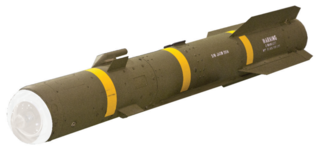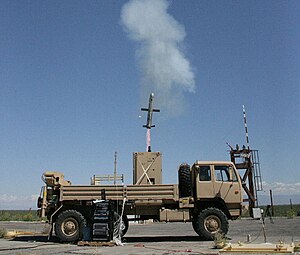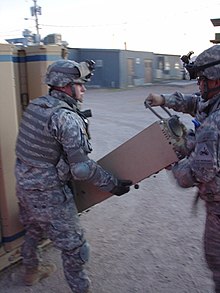
The BGM-109 TomahawkLand Attack Missile (TLAM) is a long-range, all-weather, jet-powered, subsonic cruise missile that is primarily used by the United States Navy and Royal Navy in ship and submarine-based land-attack operations.

The FGM-148 Javelin, or Advanced Anti-Tank Weapon System-Medium (AAWS-M), is an American-made man-portable anti-tank system in service since 1996, and continuously upgraded. It replaced the M47 Dragon anti-tank missile in US service. Its fire-and-forget design features automatic infrared guidance, allowing the user to seek cover immediately after launch, in contrast to wire-guided systems, like the system used by the Dragon, which require a user to guide the weapon throughout the engagement. The Javelin's high-explosive anti-tank (HEAT) warhead can defeat modern tanks by top-down attack, hitting them from above, where their armor is thinnest, and is also useful against fortifications in a direct attack flight. The javelin uses a tandem charge warhead to circumvent an enemy tank's explosive reactive armor (ERA) which would normally make HEAT warheads ineffective.

The M982 Excalibur is a 155 mm extended-range guided artillery shell developed in a collaborative effort between the U.S. Army Research Laboratory (ARL) and the United States Army Armament Research, Development and Engineering Center (ARDEC). The Excalibur was developed and/or manufactured by prime contractor Raytheon Missiles & Defense, BAE Systems AB and other subs and primes in multiple capacities such as Camber Corporation and Huntington Ingalls Industries. It is a GPS and inertial-guided munition capable of being used in close support situations within 75–150 meters (250–490 ft) of friendly troops or in situations where targets might be prohibitively close to civilians to attack with conventional unguided artillery fire. In 2015, the United States planned to procure 7,474 rounds with a FY 2015 total program cost of US$1.9341 billion at an average cost of US$258,777 per unit. By 2016, unit costs were reduced to US$68,000 per round. Versions that add laser-guidance capability and are designed to be fired from naval guns began testing in 2015. By October 2018, over 1,400 rounds had been fired in combat.
The FGM-172 SRAW, also known as the Predator SRAW, was a lightweight, close range missile system produced by Lockheed Martin, developed by Lockheed Martin and Israel Military Industries. It is designed to complement the FGM-148 Javelin anti-tank missile. The Predator had a longer range and was more powerful than the AT4 that it was designed to replace, but had a shorter range than the Javelin.
The XM1111 Mid-Range Munition (MRM) is a 120 mm precision guided munition developed for the Rheinmetall Rh-120 120mm gun used by several Western tanks. It was also intended to fulfill a requirement for Future Combat Systems (canceled) for a long-range, beyond line of sight (BLOS) tank munition.

Spike is an Israeli fire-and-forget anti-tank guided missile and anti-personnel missile with a tandem-charge high-explosive anti-tank (HEAT) warhead. As of 2024, it is in its sixth generation. It was developed and designed by the Israeli company Rafael Advanced Defense Systems. It is available in man-portable, vehicle-launched, helicopter-launched and maritime variants.

The Direct Attack Guided Rocket (DAGR) is a weapons system under development by Lockheed Martin. The program goal is to provide a low cost 2.75 inch (70 mm) precision guided rocket which is compatible with existing Hellfire II systems and launchers in service. The system will use components from the existing Hydra 70 rocket, but differs from other upgrades to the Hydra 70 such as APKWS and LOGIR in that it is designed to be plug and play compatible with the Hellfire missile and use the M299 Hellfire launcher, increasing the load-out by up to four times. DAGR also offers a lock-on before launch capability that is not compatible with the electronics in existing Hydra 70 launchers.

The Extended Range Guided Munition was a precision guided rocket-assisted 5-inch (127 mm) shell (projectile) development by Raytheon for the U.S. Navy. The program was cancelled in March 2008 after twelve years of development and over 600 million dollars in funding. The developmental round was designated EX 171.
The Long Range Land Attack Projectile (LRLAP) is a canceled precision guided 155 mm (6.1 in) naval artillery shell for the U.S. Navy's Advanced Gun System (AGS). LRLAP was developed and produced by Lockheed Martin Missiles and Fire Control, the prime contractor being BAE Systems.

The AGM-179 Joint Air-to-Ground Missile (JAGM) is an American military program to develop an air-to-surface missile, to replace the current air-launched BGM-71 TOW, AGM-114 Hellfire, and AGM-65 Maverick missiles. The U.S. Army, Navy, and Marine Corps plan to buy thousands of JAGMs.

The AGM-176 Griffin is a lightweight, precision-guided munition developed by Raytheon. It can be launched from the ground or air as a rocket-powered missile or dropped from the air as a guided bomb. It carries a relatively small warhead, and was designed to be a precision low-collateral damage weapon for irregular warfare. It has been used in combat by the United States military during the War in Afghanistan.

Cirit is a laser-guided 70 mm missile system under production by Turkish arms industry manufacturer ROKETSAN. It is one of the projects launched by Turkey to equip the Turkish Army's T-129 Atak, AH-1P Cobra and AH-1W Super Cobra attack helicopters with low-cost precision strike capabilities. It has been selected by Eurocopter for execution of a test and integration program to equip the Eurocopter EC635. The weapon's name comes from a traditional Turkish horseback game, Cirit, where two teams of riders fight a mock battle using wooden javelins which are called cirit.

A precision-guided munition (PGM), also called a smart weapon, smart munition, or smart bomb, is a guided munition intended to hit a specific target, to minimize collateral damage and increase lethality against intended targets. During the Persian Gulf War guided munitions accounted for only 9% of weapons fired, but accounted for 75% of all successful hits. Despite guided weapons generally being used on more difficult targets, they were still 35 times more likely to destroy their targets per weapon dropped.

The AGM-158C LRASM is a stealth air launch anti-ship cruise missile developed for the United States Air Force and United States Navy by the Defense Advanced Research Projects Agency (DARPA). Derived from the AGM-158B JASSM-ER, the LRASM was intended to pioneer more sophisticated autonomous targeting capabilities than the U.S. Navy's current Harpoon anti-ship missile, which has been in service since 1977.

The AeroVironment Switchblade is a miniature loitering munition designed by AeroVironment and used by several branches of the United States military. Small enough to fit in a backpack, the Switchblade launches from a tube, flies to the target area, and crashes into its target while detonating its explosive warhead. The name Switchblade comes from how the spring-loaded wings are folded inside a tube and flipped out once released.

CM501G is a Chinese land attack missile first revealed during the 9th Zhuhai Airshow held in November 2012. Developed by China Aerospace Science and Industry Corporation (CASIC), CM-501G is also available in air and ship launched versions upon customers' requests, but only the land-based version made its public debut at the airshow.
The Pike is a precision-guided mini-missile or grenade munition designed by Raytheon. It is a 40 mm guided munition that can be fired from the barrel of a Heckler & Koch M320 Grenade Launcher Module and FN Enhanced Grenade Launching Module (EGLM) like a standard 40mm grenade, but is powered by a rocket motor to propel it 2,000 m to give infantrymen improved extended-range precision capabilities. The weapon uses a digital, semi-active laser seeker to guide itself to within five meters of the target; it can operate in a two-man shooter/spotter team or by the grenadier alone lazing after firing, as it can fly for 15 seconds before homing in. When fired, Pike has a small propellant to "kick" it 2.5–3 m (8.2–9.8 ft) out of the tube before the nearly smokeless motor ignites, and range is dependent on firing angle. The munition is effective against fixed and slow-moving mid-range targets, using a 6⁄10 lb blast fragmentation warhead with a 10-meter lethality radius. Raytheon developed the weapon for three years in collaboration with Nammo Talley, which developed the warhead and propulsion system. The Pike is intended to be more accurate with a longer range than rocket propelled grenades (RPGs) and standard rifle grenades, while being far lighter and more cost-effective than current infantry guided weapons like the $78,000 each FGM-148 Javelin. Further improvements could include different fuses, multiple-round simultaneous programming and targeting with data-link capabilities, and platform integration onto small boats, vehicles, and small unmanned aerial vehicles (UAVs). Pike weighs 1.7 lb (0.77 kg) and is 16.8 in (43 cm) long, too long to fit in the breech of the M203 grenade launcher. At AUSA 2015, Raytheon revealed they had performed two successful test firings of the Pike.
A loitering munition, also known as a suicide drone, kamikaze drone, or exploding drone, is a kind of aerial weapon with a built-in warhead that is typically designed to loiter around a target area until a target is located, then attack the target by crashing into it. Loitering munitions enable faster reaction times against hidden targets that emerge for short periods without placing high-value platforms near the target area and also allow more selective targeting as the attack can be changed mid-flight or aborted.
The Guided Multipurpose Munition (GMM) is an infantry precision guided munition being developed by Saab Group and Raytheon.















